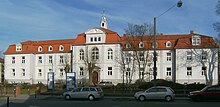St. Petri Orphanage Foundation
The St. Petri Orphanage Foundation from 1692 in Bremen has its origins in the orphanage of the parish of St. Petri Cathedral in Bremen . Today it is a youth welfare organization.
history
Orphanage from 1692 at the cathedral
Towards the end of the 17th century, the Lutheran St. Petri Cathedral Church wanted to set up a separate institution for the two Reformed orphanages that had existed since 1596/99 and 1684 , the “Red” and the “Blue Orphanage”. On formerly archbishop's territory they were given by the Swedish King Charles XI. A building was made available, prepared and inaugurated as an orphanage on November 10, 1692 (later Domshof 12). Initially, eight boys and five girls were accepted. They were looked after by an orphan father , an orphan mother and an orphan guard . The Swedish trustees ruled down to the smallest detail, for example by setting the color of children's clothing to blue-yellow. In 1700 there were already 68 children living in the orphanage, in 1720 there were 118. At times, 200 children lived in the cramped and damp building.
New building from 1785 on the cathedral
From 1783 to 1785, the foundation got a more suitable house on the corner of Sandstrasse (Domshof 8) with a classicist new building on what is now Hanoverian grounds. Soon up to 220 children lived and worked there (from 1877 exclusively boys). In 1782 school and teaching regulations were adopted. The most important reading material was the Bible , plus lessons in arithmetic , natural science and geography . Extracts from newspapers were also read out, such as a Hamburg newspaper that a Mr. Staegemann made available to the orphanage twice a week. In the course of the 19th century, gymnastics, drawing and writing letters were added. This training made it easier to find apprenticeships. In order to ensure the maintenance of the house, the orphans were obliged to work. So the orphanage accepted the completion of stockings as a commissioned work, whereby the working hours were precisely defined depending on the type and quality. As in many orphanages, poor quality work or work that is too slow was at risk of being beaten, deprived of food and sleep. Visiting relatives was also made more difficult.
During the French period in Bremen and the following years (1811–1817), the denominational status of orphanages was lifted, and Reformed orphans were temporarily admitted to the Domshof. On April 1, 1877, they came back to this and separated the facilities according to sex: the boys stayed at the Domshof, the girls moved to the orphanage Am Brill , which had been reformed up to then .
Orphanage and Police House on Stader Strasse

Again about a century after the construction of the building at the Domshof, the location and furnishings did not meet the improved requirements. A large wing building on Hamburger Strasse (today: building Stader Strasse 35 ) was opened in 1901, at that time still on the green field. The neo-baroque building was built according to plans by the architects Eduard Gildemeister and Wilhelm Sunkel. The down from the previous translocated gable porch and acquired architectural motifs such as the roof turret with belfry reminders of the old building on Domshof, who had to make way for a bank building. In 1922 the now 70 pupils were relocated to Osterholz. The building was extended and rebuilt from 1924 to 1926 according to plans by the architect Grieme. It was acquired by Bremen in 1924 and after the renovation was used for residential and accommodation purposes by the protection police and as a police station as well as part of a barracks of the State Police Regiment 27 of Bremen (Adolf Hitler barracks). After the Second World War, various commercial enterprises with predominantly office-like use as well as medical practices, discounters, rehabilitation facilities, etc. were and are located in the building complex.
Monument protection
The building has been a listed building since 2004 . Location: 53 ° 4 ′ 7 ″ N , 8 ° 50 ′ 59.7 ″ E
The foundation today
Today, the foundation has several residential groups available on the site of a former estate, as well as day groups for therapeutic education. In addition, there is flexible assistance and family assistance, therapeutic advice and assistance, which also includes therapeutic riding. Parents are trained.
For the open child and youth work in the east of Bremen, curative educational day groups, the St. Petri Horthaus Tenever and an alcohol-free youth café are available. The foundation is primarily active in the Tenever district , with the family and neighborhood center in Neue Vahr Nord and in Hemelingen , where it works through sports facilities and the Tenever children's farm , but also through cooperation with other social institutions. In addition, so-called school avoiders , in this case boys who do not want to go to school , are addressed via the bicycle park Tenever , with the leisure and conference center Maria Buck in Seebergen - community Lilenthal (Bergstrasse. 134) there is a house for leisure time, Conferences and training courses ready.
The foundation is a member of the Diakonisches Werk Bremen .
Individual evidence
- ↑ Location: 53 ° 4 ′ 33.2 ″ N , 8 ° 48 ′ 34.5 ″ E
- ^ Monument database of the LfD
- ↑ Sudwalder Strasse 53 ° 3 ′ 19.1 ″ N , 8 ° 56 ′ 55.4 ″ E
literature
- Wilhelm Lührs: The Domshof . (Staatsarchiv Bremen :), Bremen undated [1979], pp. 134–138 (on Domshof 12), pp. 118–123 (on Domshof 9), note 133 (literature on institutional and building history).
- Karl-Heinz Wriedt: Sometimes joy, sometimes sorrow. The history of the St. Petri Orphanage Foundation from 1692 . St. Petri Orphanage Foundation, 1992.
- Childhoods, part 1, institutional education in the 19th century , (= contributions to the social history of Bremen, issue 1), Bremen undated [1981]
